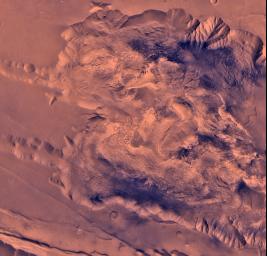West Candor Chasma
Caption:
During its examination of Mars, the Viking 1 spacecraft returned images of Valles Marineris, a huge canyon system 5,000 km long, up to 240 km wide, and 6.5 km deep, whose connected chasma or valleys may have formed from a combination of erosional collapse and structural activity. The view shows west Candor Chasma, one of the connected valleys of Valles Marineris; north toward top of frame. The image is a composite of Viking high-resolution (about 80 m/pixel or picture element) images in black and white and low resolution (about 250 m/pixel) images in color. The Viking 1 craft landed on Mars in July of 1976. West Candor Chasma occupies the westernmost part of the large west-northwest-trending trough of Candor Chasma. This section is about 150 km wide. West Candor Chasma is bordered on the north and south by straight-walled cliffs, most likely faults, and on its west by two segments of north-northeast-trending cliffs. The north wall is dissected by landslide scars forming reentrants filled with landslide debris. The south wall shows spur-and-gully morphology and smooth sections. The high-standing central mesa, informally dubbed Red Mesa has several curvilinear reentrants carved into the caprock, whose anomalously colored layers were interpreted to be caused by young hydrothermal alteration products (Geissler et al., 1993, Icarus, v. 106, p. 380-391). Light-colored lobes flow away from the top of the interior stack and then flow around and embay the same layered stack from which they originated. One of these apparent flow features is composed of at least two or perhaps even three huge, superposed, vaguely layered, very rugged, light-colored lobes as much as 100 km long, 20 km wide, and over 2 km thick. The layered deposits below the caprock also merge with a chaotic material that has local lobate fronts and overlaps landslide deposits. Hummocky material, similar in hue to wall rock, fills the southwestern-most region of west Candor Chasma and is perhaps as much as 3 km thick (Lucchitta, 1990, Icarus, v. 86, p. 476- 509). The light-colored lobes, chaotic material, and hummocky fill may be mass wasting deposits due to wholesale collapse of older interior deposits (Lucchitta, 1996, LPSC XXVII abs., p. 779- 780); this controversial idea requires that the older layered deposits were saturated with ice, perhaps from former lakes and that young volcanism and/or tectonism melted the ice and made the material flow.
Cataloging Keywords:
| Name |
Value |
Additional Values |
| Target |
Mars |
|
| System |
|
|
| Target Type |
Planet |
|
| Mission |
Viking |
Mariner |
| Instrument Host |
Viking 1 Orbiter |
|
| Host Type |
Orbiter |
Flyby Spacecraft |
| Instrument |
Visual Imaging Subsystem - Camera A |
|
| Detector |
|
|
| Extra Keywords |
Color, Thermal, Volcano |
| Acquisition Date |
|
| Release Date |
1998-06-08 |
| Date in Caption |
|
|
| Image Credit |
NASA/JPL/USGS |
| Source |
photojournal.jpl.nasa.gov/catalog/PIA00403 |
| Identifier |
PIA00403 |

